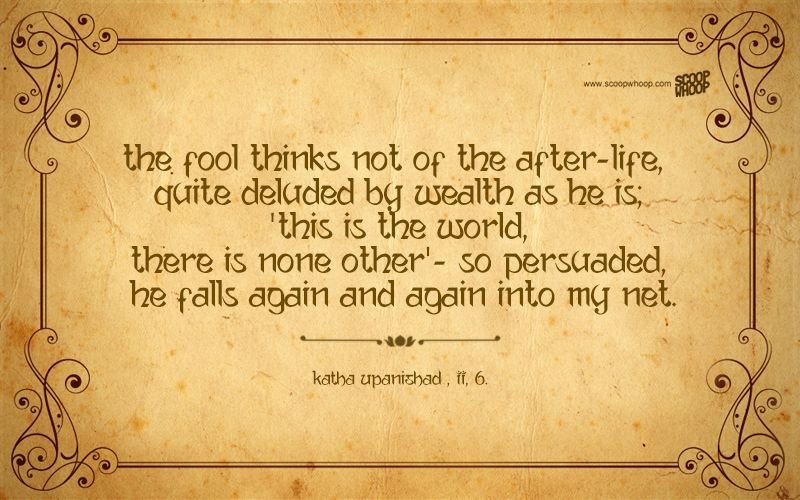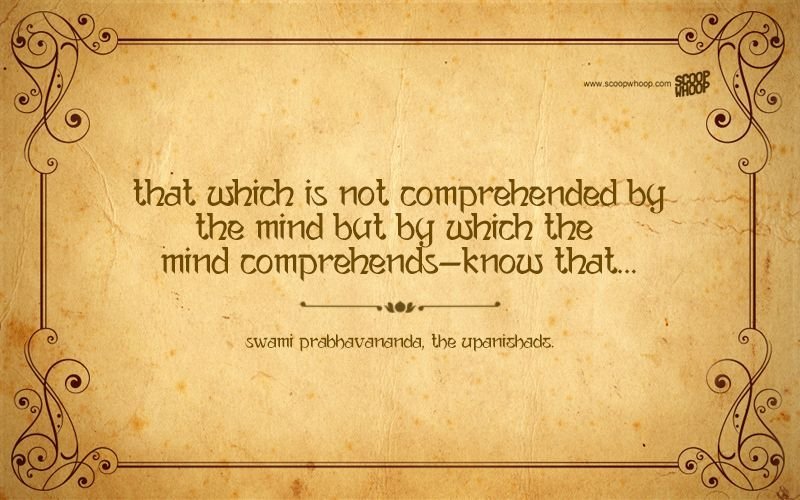고정 헤더 영역
상세 컨텐츠
본문

- Summary Of The Upanishads
- Upanishads Quotes About Love
- Upanishads Quotes About The Heart
- Quotes From Upanishads
4292 The Upanishads Katha Upanishad 5.15; Mundaka Upanishad 2.2.10; Svetavatara Upanishad 6.14 F ools dwelling in darkness, but thinking themselves wise and erudite, go round and round, by various tortuous paths, like the blind led by the blind. Upanishads are an amazing collection of writing from oral transmissions. Here are some of the amazing quotes from Upanishads. That immortal Brahman alone is before, that Brahman is behind, that Brahman is to the right and left. Brahman alone pervades everything above and below; this universe is that supreme Brahman alone. 4292 The Upanishads Katha Upanishad 5.15; Mundaka Upanishad 2.2.10; Svetavatara Upanishad 6.14 F ools dwelling in darkness, but thinking themselves wise and erudite, go round and round, by various tortuous paths, like the blind led by the blind. Important quotes. Reading through the over two hundred Upanishads would be a difficult and tedious task. Many of the themes and discussions are repeated in various ways, so a full reading is not necessary. There are many famous and powerful quotes from these texts that can serve as powerful reminders and seeds of contemplation. Shanti – peace - is a most essential quality expressed in the ancient Vedic texts of the Upanishads. It is invoked at the beginning and the end of each Upanishad chapter. — In 'Bhakti - the Yoga of Love: Trans-rational Approaches to Peace Studies', in p.78.
There are a handful of ancient texts that modern day yogis turn to for foundational wisdom. Patanjali’s Yoga Sutras are one of them; the Upanishads are another.
A collection of philosophical texts, the Upanishads were written in India sometime between 800 and 500 BC. They emerged from a time of shifting spiritual sensibilities, when traditionally Vedic Indians were moving away from external religious practices to more internally-focused spiritual pursuits—put very simply, fewer sacrifices and more meditating.
The books of the Upanishad are made up of the teachings of that day’s spiritual leaders and guides. Although we refer to them collectively, each book (there are about 200 total) stands on its own. The name Upanishad reflects its content: upa (near) and shad (to sit) form to mean something close to “sitting down near,” that is, sitting at the feet of a sage to embark on a session of spiritual study.
Of all the concepts unpacked in the Upanishads there are four that we’ll look at in a little more depth over a series of posts: samsara, karma, dharma and moksha.
Dharma
Ancient terms are tough to translate, and dharma [धर्म] is no exception. The Sanskrit root dhṛ means “to hold, maintain, keep,” and can be understood to mean “an established law.” Another definition gives the meaning “to support, hold, or bear” and is used alongside the concept rta, the order that makes life and universepossible; dharma is a steadfast condition that allows change and growth to occur.
In Buddhism dharma means “cosmic law and order;” in Sikhism, it means the path of righteousness and proper religious practice.
I first understood dharma to mean “one’s work in the world,” a concept that expands to hold one’s duties, rights, obligations, laws, standard of conduct and virtues; in short, a right way of living.
In the Bhagavad Gita Krishna tells a conflicted Arjuna:
“It is better to do your own dharma even imperfectly, than someone else’s dharma perfectly.”
At this point in the story Arjuna, facing a great battle, does not want to fight. Krishna points out that going into battle is Arjuna’s dharma. Arjuna is a warrior, so despite his reservations, his path lies on the battlefield.
Our dharmas are bigger than us. Specific courses to chart in the world, they may not be easy to navigate, but, as Krishna reminds Arjuna, it’s better to forge ahead than taking a path that wasn’t meant for us. The effort we put into following our dharma is as important as any result or outcome. It is the labor and not the fruits that are important.
Patanjali expands on the concept of dharma and right living in the The Yoga Sutras. The yamas and niyamas are restraints and observances that serve as guidelines for social action; they are the foundational ways of being that uphold order and make life possible. While dharma can be understood to be personal, it is also universal: Just as we each have our own unique dharma—the work we have to do in the world, with its own singular share of challenges, gifts, obstacles, and victories—there is a collective dharma we participate in as spiritual community members, as well.
In a 21st century yoga context, the concept of dharma is akin to reminding yourself not to compare yourself to the person on the mat next to you. On and off the mat, do your practice with compassion for your limitations and gratitude for your gifts; let go of any attachment to the outcome; and uphold the collective with your actions and conduct. That’s your dharma.
Photos: Dharma wheel; Bhagavad Gita.
The philosophical basis of Hinduism and Advaita: What are the Upanishads?
After the Vedas the Upanishads are the most revered texts in Hinduism.
Summary Of The Upanishads
The Upanishads are texts which contain the basis of the later philosophy of the Hindus. Vedanta especially is based on the Upanishads.
On this blogpost I illustrate the basic thought in the Upanishads with quotes from the principle Upanishads.
Tradition about the Upanishads
Also spelled: upanisad, upanisads
The Upanishads were said to be the reflection of teachings given by the teacher (or guru) to the student. The word Upanishad can be said to mean ‘sitting near’.
Key concepts discussed in the Upanishads include: the soul, reincarnation, karma, Brahman and liberation.
The insights in the Upanishads were later put into systematic form by the Vedanta (which means “end of the veda’s”). In other words: the most famous of Indian philosophies – Advaita Vedanta – goes back to these teachings.

Aum in the Upanishads
Many of the key ideas and religious concepts were first formulated in the Upanishads. For instance:
Chandogya Upanishad 1:1:1 quote:
Upanishads Quotes About Love
Aum. One should meditate on this syllable, the udgitha, for one sings the loud chant beginning with Aum.
Upanishads Quotes About The Heart

Quotes From Upanishads
Self Realisation and Health Upanishad Quotes
The basic Hindu concept or deliverance (moksha) is also introduced in the Upanishads:
Isha Upanishad Verse 2 quote
Every person should live a complete life span of hundred years. And he should constantly strive to fulfill the purpose of life i.e. Self-Realization.
Also:
Katha Upanishad 1:2:1
There is a path of joy and there is the path of pleasure. Pondering on them, the wise (one) chooses the of joy; the fool takes the path of pleasure.
Katha Upanishad 1:2:2
Both the good and the pleasant approach a man. The wise man, pondering over them, discriminates. The wise chooses the good in preference to the pleasant. The simple-minded, for the sake of worldly well-being, prefers the pleasant.
Mundaka Upanishad 2:2:8
One who meditates, all his knots of his heart, the bondages are opened; all the doubts are eliminated and one becomes gradually free from the fetters of action with ego.
The Self (Atman) is the All (Brahman)
The famous central insight in most of Hinduism is that Atman (the highest Self) is identical to the essence of the universe (Brahman), as is illustrated by these quotes.
Mundaka Upanishad 2
All this is, verily, Brahman. This self is Brahman. This same self has four quarters.
And to make the meaning of this Brahman clear:
Narashimha Upanishad 7:3
“Everything is God”
Get the Upanishads
I can’t rave about Penguin Classics enough. In this case they did the job again. They gathered the most important Upanishads together, had them translated by a real professional and made the result affordable as well.
What more can you ask for?
Bhagavad Gita
Of all the upanishads the Bhagavad Gita is the most famous. It sums them all up and it is also in modern times become a kind of Bible to Hinduism.
The Penguin Classics are always excellent translations of classic texts. This text is no exception. Juan Mascaro is a poet who loves the Gita and learned Sanskrit to be able to read it. This doesn’t mean he stopped there: he studied Sanskrit for years and years before finally finishing this translation.
Anyone interested in Hindu Spirituality or even just alternative spirituality should have a copy of the Gita at home, within reach.
And if you are going to have a Bhagavad Gita – this is truly one of the best translations to have. Why settle for less?






댓글 영역